Lemur conservation requires poverty alleviation initiatives in Madagascar
An interview with lemur expert Charlie Welch:
Lemur conservation requires poverty alleviation initiatives in Madagascar
Patience and a sense of humor help too
Rhett A. Butler, mongabay.com
November 5, 2006
Madagascar, an island larger than France that lies off the southeastern coast of Africa, is perhaps best known for its lemurs—primates that look something like a cat crossed with a squirrel and a dog. These animals are unique to the island and display a range of interesting behaviors from singing like a whale to sashaying across sand like a ballet dancer. Lemurs also serve as a charismatic representation of the island’s biodiversity and its problems.
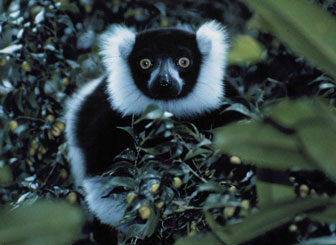 Black and White Ruffed Lemur (Varecia variegata variegata) at Betampona. Photo courtesy of Charlie Welch. |
At one time more than 100 types of lemurs — ranging from tiny mouse lemurs to gorillas-sized goliaths — existed on the island, but since the arrival of mankind some 2000 years ago, dozens of species have disappeared, hunted into extinction and suffering from habitat loss induced mostly by human activities (especially land-clearing with fire). A similar fate has befallen most of Madagascar’s largest animals, including pygmy hippos, monstrous tortoises, and the giant Elephant bird (Aephornis maximus) that once stood ten feet (3m) tall, weighed over 1100 pounds (500 kg), and laid an egg large enough to make an omelette to feed 150 people.
This biodiversity loss continues today through habitat destruction and hunting. However, addressing these issues is difficult because Madagascar is among the world’s poorest countries. As such, people’s day to day survival is dependent upon natural resource use. Most Malagasy never have an option to become a doctor, factory worker, or secretary; they must live off the land that surrounds them making use of whatever resources they can find. Their poverty costs the country and the world through the loss of the island’s endemic biodiversity.
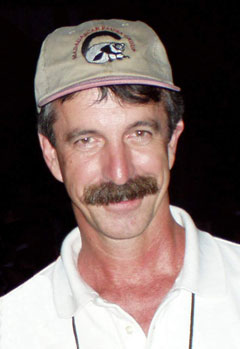 Charlie Welch, Research Scientist/Madagascar Programs, Duke University Lemur Center |
The good news is that because of Madagascar’s biodiversity, the island has become a top priority for global conservation. At the forefront of these efforts is the Madagascar Fauna Group (MFG), an international consortium of zoos and related organizations that work to protect Madagascar’s wildlife and ecosystems, and the Duke University Lemur Center, the one of the world’s leading lemur research facilities.
Charlie Welch, currently a research scientist at the Duke University Lemur Center, recently answered some questions on his experiences in lemur conservation. Welch, along with his wife Andrea Katz, has worked in Madagascar for 17 years and helped transform conservation efforts in the country. Welch assisted in the development of Parc Ivoloina as a multifaceted conservation center in Madagascar and helped establish the first captive-breeding and release program for reintroducing endangered lemurs into the wild. Both Welch and Katz were “knighted” (Chevalier de l’OrNational) for their efforts by the Malagasy government in 2004.
Rhett A. Butler (Mongabay):
How did you get involved in lemur conservation and research?
Charlie Welch (Welch):
I worked at zoos starting in high school, and eventually specialized in primates, which I found fascinating. I ended up at the Duke Primate Center (now known as the Duke Lemur Center) where I met my wife, Andrea Katz. Andrea and I had become increasingly interested in what could be done to contribute to conservation of lemurs in their country of origin, Madagascar.
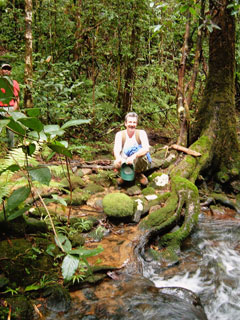 Charlie Welch in the tropical forest of Madagascar. |
The Primate Center was actively working in Madagascar, and the Madagascar Department of Water and Forests was seeking help to rehabilitate the small zoo of Ivoloina on the east coast, and to train their personnel there in captive husbandry. In 1987 we first visited the park to do a small feasibility study, and ended up living and working there for the next 17 years on what became the Ivoloina Project, and later at Betampona Reserve as well. Although the project began as primarily captive lemur work, we quickly recognized the need to expand our objectives if we really wanted to have a conservation impact.
By the time we left Madagascar in 2004 the project included aspects of environmental education, training and capacity building (for Malagasy conservation professionals and students), agroforestry and sustainable agriculture, and research, all of which feed back into the ultimate goal of conservation. By finding ways to protect intact natural forest, you also protect all that makes its home there, plants as well as animals.
Mongabay:
How does the Madagascar Fauna Group help conserve Madagascar’s biodiversity? How does the Madagascar Fauna Group raise awareness of Madagascar’s wildlife here in the United States?
Welch:
The MFG helps to conserve Madagascar’s biodiversity through its in-country projects at Ivoloina, and Betampona. As I mentioned above, the projects are strongly involved in areas of environmental education, training and capacity building (of Malagasy conservation professionals and students), agroforestry and sustainable agriculture, and research. All of these aspects impact conservation of biodiversity.
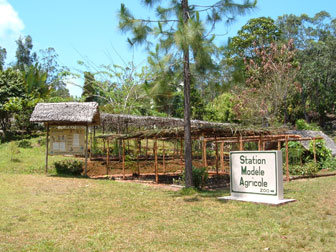 Sustainable tree nursery with native trees and palms at the Ivoloina Agricultural Demonstration Station. Photo courtesy of Charlie Welch. |
The MFG is a consortium made up of zoos, research centers, aquariums, and botanical gardens from around the world, all with a common commitment to conservation in Madagascar. Each member institution has its own education programs, and on-site graphics, and publications where they often present the conservation challenges in Madagascar to their public audiences. Some members even donate or raise money for specific mini-projects at one of the two Madagascar project sites.
Mongabay:
A lot of conservation dollars have gone into Madagascar over the past decade. What’s your long-term outlook for conservation on the island. Have conservation efforts moved quickly enough to stave off further loss of Madagascar’s spectacular biodiversity? How can conservation be improved?
Welch:
It is true that there has been a great deal of focus on Madagascar by the international conservation community in recent years. Because it is an island which has been isolated for many millions of years, a very high percentage of both plants and animals found there have followed unique evolutionary paths, hence exist no where else in the world (are endemic to Madagascar). In addition, Madagascar is made up of a set of biomes ranging from rainforest to spiny desert, such that each biome has its own unique set of flora and fauna that may not exist in other regions of the island. Unfortunately, less than 10% of the total of Madagascar remains in its former natural vegetation cover, leaving many species threatened with extinction. For those reasons Madagascar has been designated as a biodiversity hotspot and deemed a priority for conservation work.
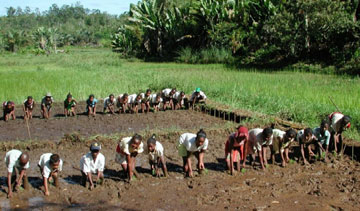 Students learning System of Rice Intensification (SRI) technique of intensive rice cultivation as alternative to slash and burn. Plots were planted as a competition between schools. Photo courtesy of Charlie Welch. |
A significant complicating factor for conservation work in Madagascar is poverty. Madagascar is a very poor developing country with many pressing problems, such as feeding its people. The disappearance of natural forests has been primarily due to subsistence agricultural practices such as slash and burn farming, and burning for cattle grazing. Many rural Malagasy have no alternative but to continue these environmentally damaging practices simply to feed their family from day to day. There is actually a widespread understanding that the agricultural practices are destructive, but people feel that they have no other choices. Almost all conservation projects ongoing in Madagascar have education and developmental components which try to teach and give locals agricultural alternatives and other advantages such as improved health care — it is not enough to simply designate a protected area and forbid unauthorized entrance. The local people must support the existence of a park or project, or its long term success will be at risk.
The good news is that the president of Madagascar, Marc Ravalomanana, strongly supports conservation of his country’s natural heritage. In fact, he has committed to tripling the amount of protected area in parks and reserves. The international conservation community is helping to meet that enormous challenge.
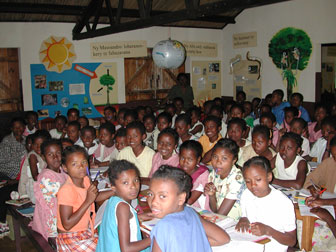 Students attending special Saturday environmental class at the Ivoloina Education Center. Photo courtesy of Charlie Welch. |
Truthfully, conservation efforts could not be said to be moving quickly. Much work is on-going, and there is very definitely progress on many fronts, but forests are still disappearing. The scale is so enormous with limited communication and movement capabilities within the country, that it is difficult to affect wide scale and lasting change. Conservation work in such a situation can be frustrating, but it is important not to become overwhelmed by the difficulties — even small projects can have an important impact in a limited area, which in time can spread.
In the end, improved and stronger national and regional economies will go far towards easing pressure on the forests.
Mongabay:
How do “normal” Malagasy, those not involved with conservation as guides or park rangers, take to conservation? Are there conflicts between conservationists and locals simply trying to eke a living from their surroundings?
Welch:
Conservation has at times been a hard sell. As I mentioned above, local people’s primary concern is feeding their families, and conservation projects must show a sensitivity to this, and exhibit a willingness to work with the people to solve their problems, and improve their lives. Good land management can benefit both man and animals.
Mongabay:
Is there anything people can do abroad to help save lemurs and Madagascar’s wildlands? What role does eco-tourism have in conservation on the island?
Welch:
The obvious is to pick out a conservation organization and perhaps a specific project, and fund raise for a donation. You can visit your local zoo, garden, or aquarium to find out if they are an MFG member — if they are, there may be ongoing projects that you could get involved in, and if they are not you could encourage them to join! The MFG web site at savethelemur.org gives current news of the work of the MFG team in Madagascar.
Ecotourism is a growing industry in Madagascar, but is still in its infancy. If managed properly it can have a conservation impact by passing on the direct benefits of preserved natural lands to the local people, as well as the population as a whole.
Mongabay:
Not to imply any bias, but I have to ask, what’s your favorite lemur?
Welch:
Oh my, that’s a tough one! I guess I would have to say the east coast sifaka, which is know as simpona. They are large lemurs with gorgeous burnt orange across their arms and legs. They can move through the forest so gracefully from vertical tree trunk to tree trunk.
Mongabay:
Do you have any especially unusual experiences either in Madagascar or with transporting lemurs?
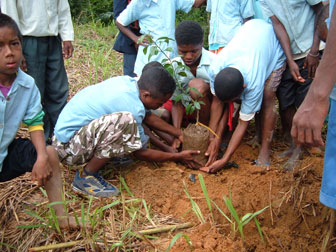 Students learning how to plant fruit trees at the Ivoloina Agricultural Demonstration Station. Photo courtesy of Charlie Welch. |
Welch: Our work at Betampona Reserve started off as a project to reintroduce captive Black and White Ruffed Lemurs, but evolved into research and monitoring of a myriad of plant and animal species that live in the reserve. We were working with a fresh water fish specialist to try and determine if the streams within and immediately surrounding the reserve contained any new species. One of the Malagasy locals who had worked for the MFG for years was sent on a mission to collect fishes in a stream outside of the western boundary of the reserve. He was given small jars containing formalin to put the fish in — the specimens would have to be taken back to the US for positive identification.
When he returned with jars containing fish, I was astounded to see that the fish were alive and happily swimming around! I began thinking, what kind of fish are these that can survive in formalin? Finally after getting a translation from Malagasy to French (accompanied by lots of laughing), the story emerged. Our fish-catcher had indeed quickly caught some specimen fish and placed them in the jars, but to his dismay they kept quickly dying in the jars. He noticed that the “water” in the jars had a strong odor, so he just dumped it, rinsed the jars, and refilled the jars with water from the stream in which the fish were completely content! We all had a great laugh, but hardly had the heart to tell him that the fish were supposed to expire, and become important specimens for identification. What struck me about this incident was that our fish-catcher so understood the objective of our conservation work, that it did not even occur to him that we intended for a few fish to die (in the name of science, and to illustrate the importance of protecting this last fragment of lowland rainforest in the area). I will never forget that.
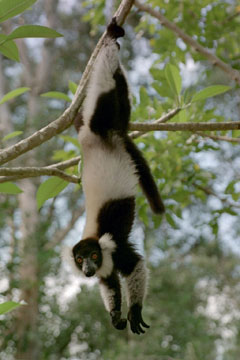 Black and White Ruffed Lemur (Varecia variegata variegata) at Ivoloina. Photo courtesy of Charlie Welch. |
When we were transporting the Captive Black and White Ruffed Lemurs from the US to Madagascar for reintroduction into natural forest, the animals had to endure an arduous trip in plastic pet kennels, in the animal hold of various aircraft. From the Duke Lemur Center in Durham, NC, they first flew to a US international airport where they then departed for Paris. During the 6 hour layover at Charles de Gaulle airport in Paris, the animals were fed and watered. Then from Paris, they were put on an aircraft for the 10 hour flight to Antananarivo, the capital of Madagascar.
I met the lemurs and the accompanying veterinarian at the airport in Antananarivo, but despite help from the US embassy became mired in an unexpected need for government veterinary authorizations. By the time we had the proper permits in hand, we had missed our connecting flight to Tamatave on the east coast, where the projects are based. So I was left with no choice but to seek out a nearby hotel for the night, for myself and the lemurs.
In case you don’t know what Ruffed Lemurs are like, they are capable of a very loud and explosive barking/roaring vocalization — and once one starts up, the others usually chime in, and can go on and on. I got myself and the lemurs settled into the hotel room, with skeptical glances from the hotel staff. They were kind enough to allow the lemurs into the room, but I was sure they would kick us out if the lemurs started vocalizing, and I don’t know where I could have gone with them in the middle of the night. I didn’t dare venture from the room, and all through the night, and at every growling (which they emit before the loud roar) I would stick a piece of banana in their mouths. Thankfully we made it through to morning and were able to catch a flight to Tamatave without further incident.
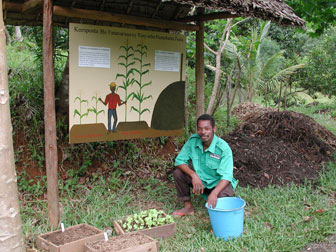 Jacques, the supervisor/educator at the Ivoloina Agricultural Demonstration Station, along side the garden composting graphics and demonstration. Photo courtesy of Charlie Welch. |
Once in Tamatave, the lemurs were placed on a project Landcruiser the following day, and driven the two hours to the end of the paved road, near to the reserve of Betampona. From there, the village of Fontsimavo, the animal crates were lashed to long, thick bamboo poles, and carried by MFG Conservation Agents for the last 2.5 miles across rivers, and up the mountain to the reserve edge village of Rendrirendry. There the animals were let out of their travel crates for the first time, and into spacious acclimatization cages. After several weeks in the acclimatization cages, and thorough vet check-ups, the lemurs were radio collared and taken to release cages in the forest where they spent 5 days to a week before being released into their ancestral home, where the survivors are still monitored today.
Mongabay:
How much time do you spend in Madagascar?
|
|
Welch:
Since we moved back to the US in 2004, I get back to Madagascar once or twice a year, but only for weeks at a time. Andrea and I are in weekly contact with the Madagascar projects via email, but Karen Freeman and Gareth Kett are doing an excellent job of carrying on and expanding the projects.
Our 13 year old daughter, Alena, enjoys getting back to visit her Malagasy friends when she gets the chance to come along — she spent the first 11 years of her life in Madagascar and at times misses it terribly, as do we.
Mongabay:
Do you have any tips for students wanting to pursue a career in primate conservation?
Welch:
- Be proactive about volunteer opportunities. Look for opportunities to volunteer by starting out locally – inquire at zoos, museums, conservation organizations, etc. near to where you live. Experience is important, and will also let you know if you want to continue along the same line. For internships, be willing to pay your own way if necessary, as a trade off for the experience — think of it as an investment.
- While taking university classes, do not be too specific with the scope of the classes you choose. In addition to the standard zoology, animal behavior, and conservation biology classes, try to work in related classes such as ecology, and botany. Every field primatologist finds botanical knowledge useful, but many have little formal training. Understanding of GIS mapping is becoming essential for conservation work of all types. Think outside of the box about what training you may need and get the advice of other field researchers, and those working in conservation.
- Still about useful skills — do not ignore language training. One of the most useful tools for anyone working overseas is the ability to communicate. Spanish is probably the most useful for American students interested in working in the new world, and French for those interested in the Africa region. Take advantage of study abroad opportunities to hone language skills. Language proficiency is very important, yet often ignored by researchers in training. Even if one were to completely change career directions, ability in a second language is almost always a bonus.
- Lastly, I think I would warn that really impacting conservation of primates (or all flora and fauna for that matter!) means having the ability to work well with people. Sometimes people get into animal work of one type or another because they feel that they don’t relate well to people. Truly impacting conservation means interacting with people in a positive manner, whether it be indigenous locals, government officials, foreign students, or conservation professionals. It can take tons of patience, and sensitivity to a different culture, but in the end is an absolutely essential skill. Of course this is not the sort of thing that is taught in a university (I don’t think) yet is often overlooked, and misunderstood by researchers and conservationists.
About Charlie Welch
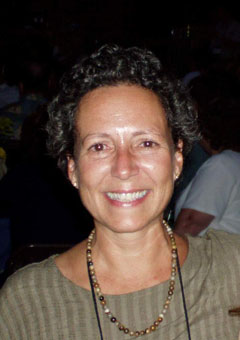 Andrea Katz, Staff Specialist for Madagascar Programs at the Duke Lemur Center and Charlie Welch’s wife. |
Charlie Welch, along with his wife Andrea Katz, worked in Madagascar for 17 years (1987-2004), first on behalf of the Duke University Lemur Center, then later as Technical Advisor for the Madagascar Fauna Group (MFG). The initial focus was to rehabilitate Parc Ivoloina, which grew into a multifaceted conservation center. Charlie was also Program Director for the Betampona Nature Reserve conservation and research program which revolved around the first-ever restocking of captive-born lemurs (Varecia variegata) into the wild. In recognition of their conservation work in Madagascar, Charlie and Andrea were “knighted” (Chevalier de l’Ordre National) by the Malagasy government in 2004. Charlie works now for the Duke Lemur Center’s Madagascar Programs and continues as an Advisor to the MFG.
Prior to working in Madagascar, Charlie gained field experience working as a research assistant for primate studies in Costa Rica, Panama, and Ecuador. Before that he also worked in zoos in Louisiana, Mississippi, and Georgia.
MORE INFORMATION
- savethelemur.org: The Madagascar Fauna Group
- lemur.duke.edu: Duke Lemur Center